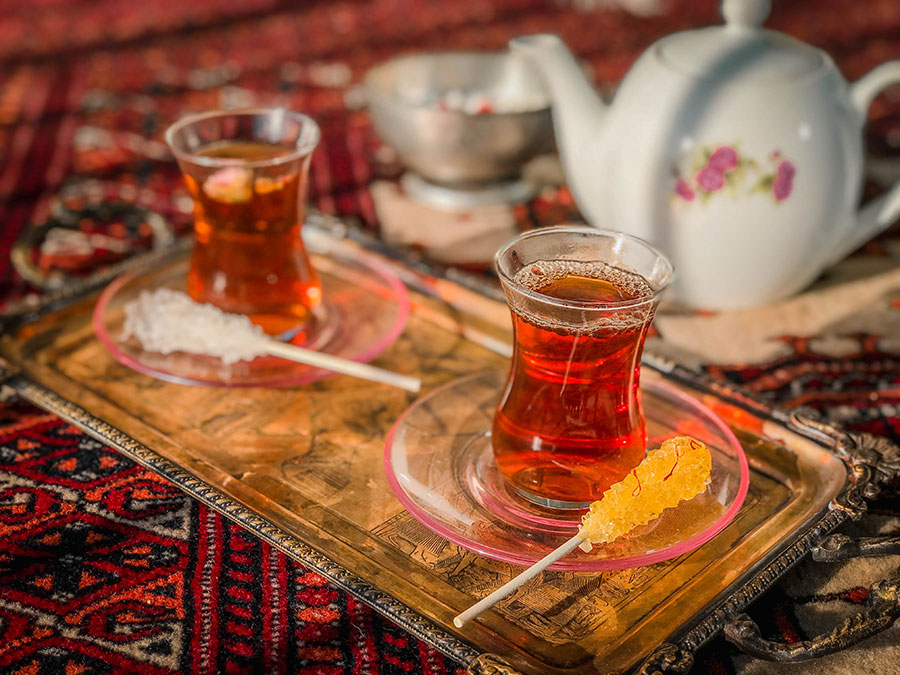Tea didn’t find its way to Persia until the 17th century when it became an expensive luxury. Qajar attempts to grow tea in Iran had been unsuccessful until Haj Mohammad Mirza, also known as Kashef-ol Saltaneh, was sent to India as the Iranian consulate. He managed to learn the secrets of tea plantation and slipped home to Lahijan with some 4000 tea plants and the rest is history.
As of today, a big part of northern Iran along the shores of the Caspian Sea is suitable for the cultivation of tea. Especially in the Gilan province on the slopes of Alborz, large areas are under tea cultivation and thousands of people work in the Persian tea industry. That region covers a large part of Iran’s need for tea.
Iranians have one of the highest per-capita rates of tea consumption in the world and since old times every street has a Châikhâne (Tea House). Châikhânes are still an important social place where older generations gather with their friends for a chat over a delightful cup of Persian tea.
Most Châikhânes or Persian tea houses will serve tea on the stronger side unless otherwise indicated by the drinker. The stronger the tea, the higher the concentration of tannin and caffeine, so a good cup of tea is like a good cup of coffee for those who take it straight.
Persian tea comes in a variety of subtle flavours, but its defining characteristic is its deep reddish-brown colour, which tea-drinkers can choose to dilute with water depending on their preference. It’s not that easy to find a glass of fair Persian tea and most of the tea in restaurants or cafes is cheaper leaves from Ceylon.
Because of the black tea’s bitterness, many prefer to have sugar with their Persian tea. The traditional way to do this is to take a sugar cube and place it between your teeth and then sip the tea while allowing the sugar to melt. You could also dissolve a saffron rock candy in your tea before you drink it. Nabat (Rock candy), or sugar cube, can be found throughout the country and bought in spice shops for this specific purpose.
Iranians, especially in colder regions of the country drink multiple cups of tea throughout the day.
Fun fact: Between Iranian ethnicities, Azeris are well-known for drinking a lot of tea. Actually, people in Iranian Azerbaijan region are super obsessed with their Persian tea and they always drink it freshly brewed in a narrow-waisted glass or cup.
Traditionally, tea is served from a samovar, a heating vessel originally imported into Persia from Russia. Literally meaning “self-boiler”, the samovar is used to keep water hot for prolonged periods of time through a fuel-filled pipe in the middle of the structure that heats the contents surrounding it.
Any Persian will tell you that they love to drink Chai, pronounced Cha-ee.
Tea, in general, is what Persians drink in the morning, after each meal, and not to mention throughout the day. Additionally, the first drink that one if offered when visiting someone else’s home is usually a cup of Persian tea.
The Iranian way of making Persian tea:
All you need is a nice china teapot, loose black tea, a couple of cardamom and some rose petals.
Place a generous amount of loose tea, slightly crush the cardamoms in your hand and put over the loose tea with the rose petals in the teapot. Then add boiling water.
Put the lid back on and place the teapot on top of the kettle or samovar while it’s simmering on the stove in order to keep the tea warm.
The Persian tea needs to be brewed for about 15 – 20 minutes to be ready for serving.
Persian way of pouring tea:
First, pour some of the hot tea into the cup to check its colour. It must be somewhat dark. Then pour the tea back into the teapot. This will do two things:
- It will warm up the cup.
- It moves the tea inside the teapot around so that colour of the tea is even.
If the colour is light, let it steep for a little longer.
Then fill up one third to half of the cup with tea and pour hot water over it all the way to the top.
The tea shouldn’t be strong in taste and colour, if so add more hot water to make it settle.
And there it is! A perfect cup of Persian tea!






Customer
enjoyed the read, and gave me motivation to go and brew my tea on a cold day with a bad cough. I hope to visit one day… Inshallah.
Matin Lashkari
Thank you so much Eli 🙂
Customer
Beautiful. Thank you. My friends send me saffron sugar, roses, lemon verbena, and tea from Iran. I love your culture.
Customer
I can hear good sound thank you so much for sharing nice post.
Customer
What type of tea is it? It’s funny that everybody talks about the real Persian tea but then they don’t even mention if it’s black tea, oolong or what! Just “place the tea leaves… and blahblah”. What type of tea!!!
Matin Lashkari
Persian tea is black but it’s not just any black tea. It takes longer than the usual black tea to brew and the colour is not as strong. I hope that answered your question. 😉
Customer
Hi! My cousin is Iranian Persian and I am researching tea sets as a gift for her. Every time I search for Persian Tea Sets, I come up with the options being Turkish. I want to make sure I am getting the right thing, is there a difference between Turkish tea glasses and Iranian tea glasses?
Customer
Whether you choose black tea or any other tea, the health benefits can’t be understated. Find out what are the good and bad things about drinking tea.